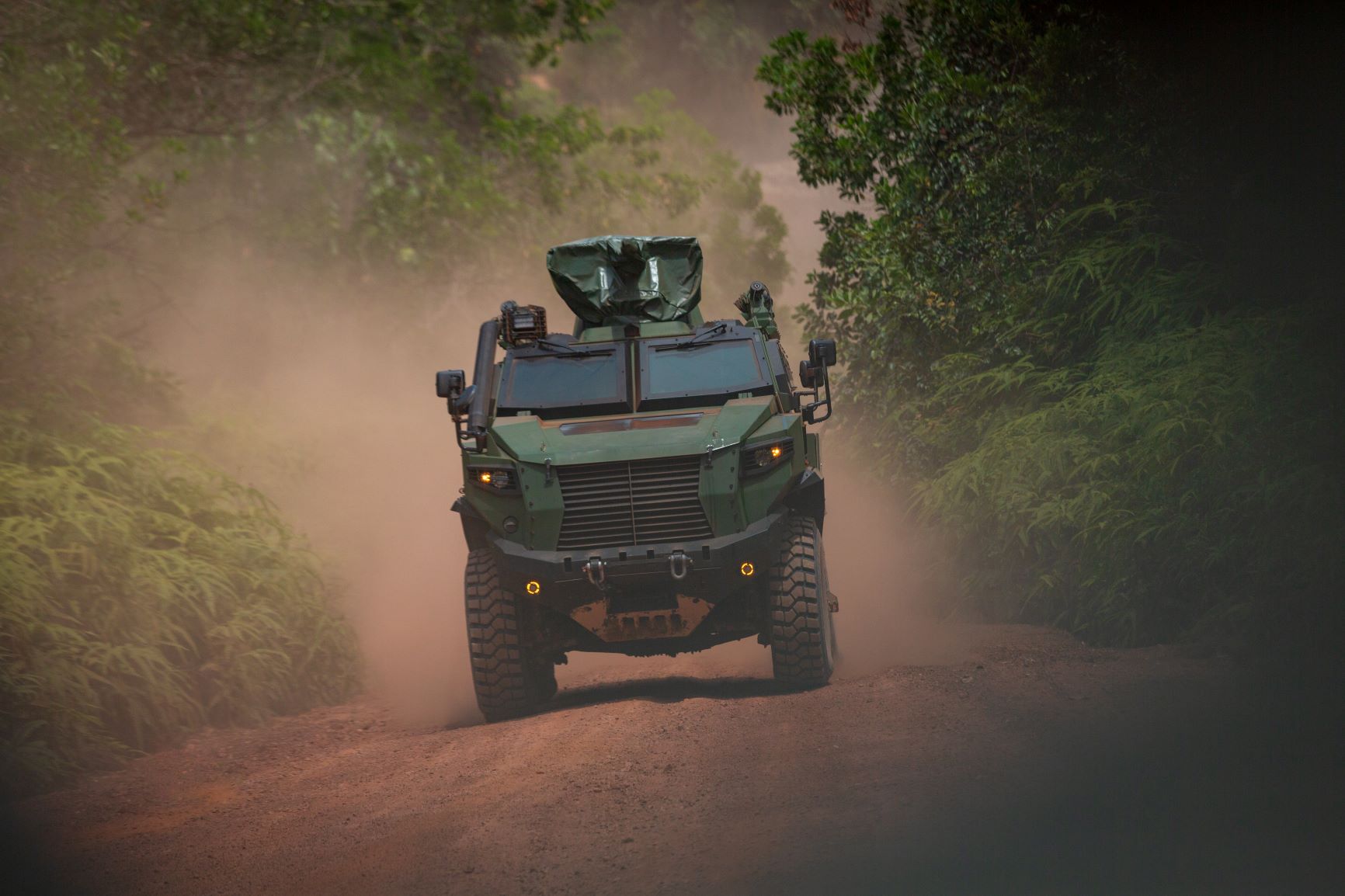
SHAH ALAM: HMAV out in the wild. Local company, Mildef International Technologies (Mildef) announced that its 4X4 High Mobility Armoured Vehicle (HMAV) had undergone some 1000km of testing on highway and off-road conditions with the Army.
The Army’s vehicle evaluation unit conducted the testing from Feb. 21 to March 5 with all the driving sessions conducted by personnel from the unit, the company said in a release today.
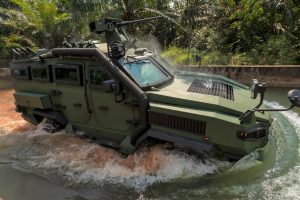
The HMAV undergoing a wading test at the Gemas range. Mildef
Apart from the Army’s vehicle testing unit, testers from the company and the Science & Technology Research Institute For Defence (Stride) from the Defence Ministry also took part in the programm. The testing, according to Mildef, was conducted based on the protocols stipulated by the Army. This was the first evaluation of the vehicle out in the wild since it was publicly launched last February.
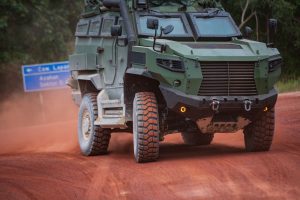
The HMAV being tested at the Gemas range.
During the testing period, the HMAV spend some 700km on highway and federal roads and 300km off-road. The evaluation started from Stride facility in Kajang before it was driven to Kuantan, Pahang, before proceeding to Terengganu, Kelantan and Kedah. The evaluation team then return to Mildef facility in Sepang before the vehicle proceeded to Gemas where various mobility tests were conducted around the range at the Sirajuddin camp.
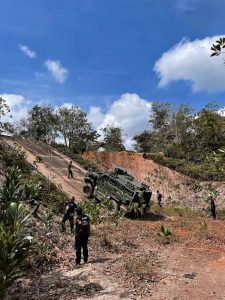
The HMAV prepped up for the up the slope test.
Pictures released by Mildef showed that the HMAV fitted with a 12.7mm machine gun but the company did not say whether any live firings were conducted during its time at the Gemas range. The evaluation ended on March 5 with the vehicle side and slope test at Stride facility in Kajang. Mildef said it will conduct further testings in the near future.
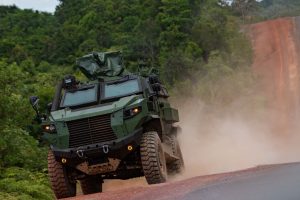
HMAV out on the wild.
— Malaysian Defence
If you like this post, buy me an espresso. Paypal Payment

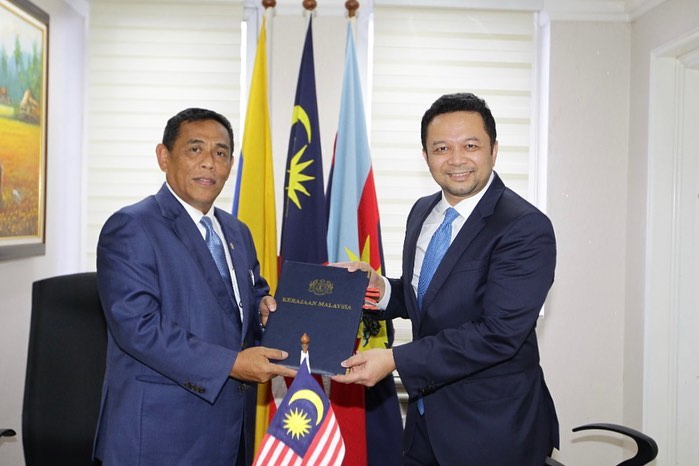

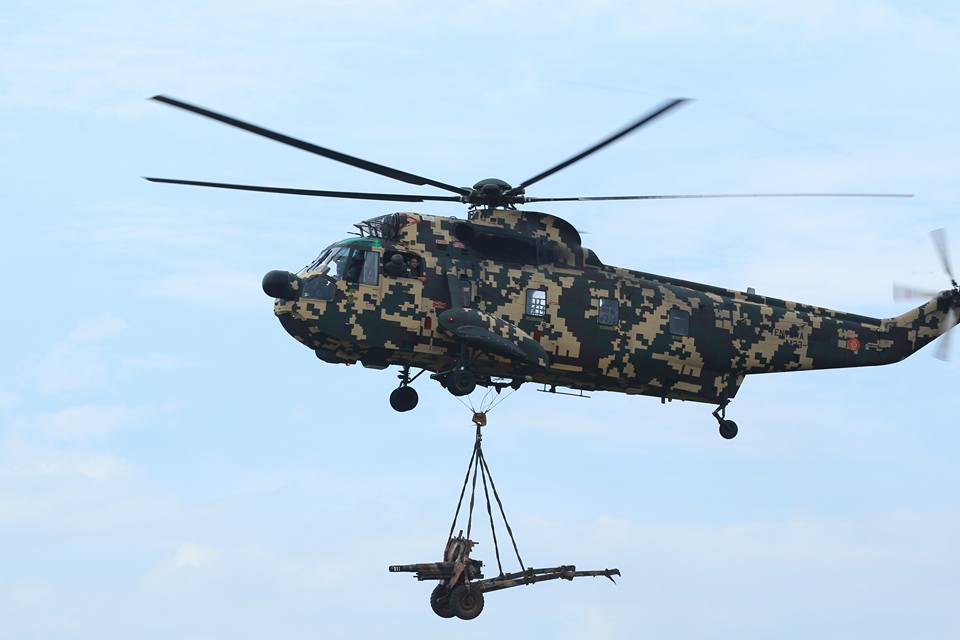
Seems like a reliable and good candidate to replace or supplement the Condors. Cant wait for the 6×6 version, which in turn will replace the Sibmas as the AFSV for the army. Even could be developed further into many variants such as ATGM carrier, Starstreaks platform, mortar carrier etc. Hope Mildef will one day even produce the medium tank for MAF and export market.
On the other hand, what is the progress of the AV4 Lipan Bara project? Does it stuck at 20 or 34 units? Any plan to increase the numbers? And what is the difference between the AV4 and the HMAV?
Lalok – “the 6×6 version, which in turn will replace the Sibmas as the AFSV for the army””
I was under the impression that it was intended to replace the Condor and it’s intended to be used as a primary transport platform rather than a fire support vehicle.
Lalok – “Hope Mildef will one day even produce the medium tank for MAF ”
There is no army requirement for a light tank. On a personal basis I don’t see why there should be one.
@Marhalim,
Did you managed to find out what make is the 50 cal RWS mount?
Reply
Nope
@lalok
AV-4 Lipanbara stop at 20 units only an no further order.
Can’t wait for the Mildef 6×6 armored vehicle. If I’m not mistaken they (Mildef) currently developing 6×6 armored vehicle and Humvee-like vehicle.
Then come the hizir guys..haha..mildef spend 4 years of rnd and 16 million myr to develop and build hmav prototype then labelled hizir rebadge by you know who
Saya tidak mahu terlalu meletakan harapan tinggi terhadap industri pertahanan kita. Di malaysia belum ada teknologi mencipta/buat logam(raw metal) mengikut kehendak/acuan kita sendiri dengan cost yang rendah dan dengan jumlah yang banyak yang mana logam adalah bahan paling asas/banyak dalam industri pertahanan.malah kita masih di peringkat awal dan susah(struggling) dengan isu standard/grade dalam indsutri pembinaan. Apatah lagi dalam military standard/gred yang sudah tentunya lebih compleks dan lebih canggih. saya bekerja di kilang vendor/subcon yang sudah membuat oil and gas equipment selama 30tahun.(teknologi dari us/france).dari segi kimpalan/pemasangan/testing kita tiada masalah malah boleh dikatakan ada harinya yang kita lagi hebat dari mereka(dari segi cost/time efective dan quality) tapi bila bercakap tentang raw material kita tewas(we dont have a clue)..biasanya mereka hanya hantar komponen raw/special material/metal ini sahaja untuk kita kimpal@pasang.(mereka tidak akan kongsi blueprintnya), dan raw material/metal ini bukan mudah untuk di reverse engineered..ia memerlukan kos yang tinggi dan memakan masa yang lama untuk RND(mungkin bergenerasi seperti mana yang mereka lakukan?)..dan ia boleh jadi satu bentuk perjudian yang besar(bagi pelabur)..raw/special material ini jikalau kita hendak beli sahaja harganya tentulah sangat tidak berpatutan. Adalah lebih jauh menjimatkan dan mudah jika hanya beli product yang sudah siap.(finish product)..adapun begitu, jikalau kita berjaya membuat/mencipta logam itu sendiri..membentuk logam(forging/machining) pada ketepatan yang tinggi itu ada salah satu cerita panjang dilain hari..dan saya hanya bercerita tentang satu bahan iaitu logam..sudah tentu banyak lagi bahan lain yang digunakan contohnya getah/plastik/kaca/chemical dan lain2. Aoa apa pun ini adalah pencapaian cukup baik dari MILDEF
A – “currently developing 6×6 armored vehicle and Humvee-like vehicle”
Actually “developing” based on indigenous R&D or modifying/tweaking an existing foreign design?
If we look at it from a logical and objective perspective; the market is saturated with 6x6s and high mobility vehicles? What added value do we get from yet another local player coming into the picture?
Given that we already ordered the Lipanbara; why aren’t we ordering more?
On paper, the Alang has a slightly more powerful engine, 330 HP compared to 300 for the AV4, but it is slightly heavier too at 14 t vs 13 for the AV 4. Maybe it’s cheaper? Deftech has the monopoly at the moment.
We keep hearing of mobility trials : vehicle moving ‘x’ km; climbing a gradient of ‘x’ degrees: fording, etc, etc.
That’s fine but logic and prudence would also dictate we perform live firings tests; i.e. if a vehicle is certified as offering all round protection to 7.62mm then we actually test it. Not enough to take the OEM’s/agent”s word for it. If a mine resistant high mobility hull offers protection against mines of certain sizes; we actually have to find out.
In all the various local tests conducted on everything from the PT-91 to Adnan to the AV8; as far as I know no actual tests were done on protection levels.
By the same token; if anybody insists that the PT-91’s protection level is “sufficient” or that ERAWA is fine; we should do a live test with a MBT LAW with them inside.
Reply
I was told that they did an actual test on one of the two AV8 prototypes. This one remains with FNSS, it is likely the one they exhibit at defence shows
Q: How does one reload ammo for a RWS located on the outside of an AFV during combat?
Reply
Very quickly if you live to tell the tale
Pencapaian yang sangat membanggakan.
Syabas Mildef.
Platform yang kelihatan cukup matang, penampilan mantap dan meyakinkan, walaupun merupakan prototaip awal.
Harap ada perolehan pada kuantiti optimum oleh Tentera Darat, sebagai sokongan penting buat Mildef melangkah lebih jauh.
All the best HMAV.
Am sure if anyone were to put in some effort to find out they likely will discover this is a rebadge or some facial change from the originator. This vehicle here is about as Malaysian as a Perodua car.
Wether it is LIpanbara or HMAV, the Army should standardize on either one to replace the Condors and other vehicles in service that have roles such as ATGM carrier, SHORAD carrier, light troop carrier, recce etc.
@aswad
Thank you for sharing your experience with us. It is already expensive for us to licence built equipements (LCS and Gempita for example) let alone to developed/processed the raw materials needed.
@Azlan
“if anybody insists that the PT-91’s protection level is “sufficient” or that ERAWA is fine”
EARAWA2 is sufficient to defeat most modern dual shape (tandem) charge munition (the type that was designed to defeat ERAs) from the front only. When talking about APFSDS, Pt-91M would not survive from many high end modern APFSDS shells even from the front (not all, keep in mind). There are several ways to increase the protection that we could do then again everything goes down to $$$ and Army’s requirement.
Luqman – “EARAWA2 is sufficient to defeat most modern dual shape (tandem) charge munition (the type that was designed to defeat ERAs) from the front only”
Can you with certainty say that the 1990’s ERAWA which was designed to deal with chemical energy rounds from that period is “sufficient” to defeat “most modern dual shape” rounds?
Also; ERAWA – like all ERAs – are intended to defeat incoming rounds from all all arcs; depending on where the modules are fitted.
My mention of ERAWA and MBT LAW is intended to point out that we don’t – largely – carry out lives tests; it’s expensive and could lead to embarrassing questions. It was not a literal question of the abilities of ERAWA.
Luqman- “several ways to increase the protection that we could do then again everything goes down to $”
It doesn’t all boil down to money ..
It depends on determining whether spending ‘x’ amount is a good long term investment or whether buying new provides a return; based on a particular design’s inherent vulnerabilities:issues (a design which has reached the end of its growth path) and the threat environment.
Luqman – “Wether it is LIpanbara or HMAV, the Army should standardize on either one to replace the Condors”
The Condor will be largely replaced by a 6×6 IFV. High mobility mine resistant platforms can partially replace part of the Condor fleet but ate really intended for different requirements.
We bought the Lipanbara for ESSCOM; shouldn’t it suffice for UNIFIL and other army units? Why are we looking at other high mobility mine resistant platforms?
As a “weapons carrier” we bought G-Wagons; then VAMTACs, then Weststars. In a few years time if yet another company offers another design: are we going to buy it?
It should be the armed services which determines what should be bought; with civilian oversight and approval. We should never be in a position where local companies drive procurement and we buy just because buying “local” is politically sound.
ERAWA2 (as used on Pendekar) are designed to counter tandem charged warheads designs, but perhaps more modern rounds have counter to this counter.
http://btvt.narod.ru/raznoe/erawa/ERAWA.htm
Nearly all (if not all of them) will have to ballistic proof test their armour and certain critical components at the very least, if not the whole vehicle, to the protection level they touted IF they intend to sell. Like all purchases noone will trust word of mouth or the shiny brochure, so there are independent test certification bodies for such matters.
https://www.tno.nl/media/6999/stanag_4569_test_certification_-_armoured_vehicle_protection_against_projectiles-_mines_and_ied-s.pdf
Reply
It’s the customer who usually pay for the destructive testing and usually it is put in the contract so it will be a small amount in a larger contract. One usually doesn’t do that if its small numbers of vehicles ordered so the customer have to trust the manufacturer that they had done that. They usually don’t apart from testing some components.